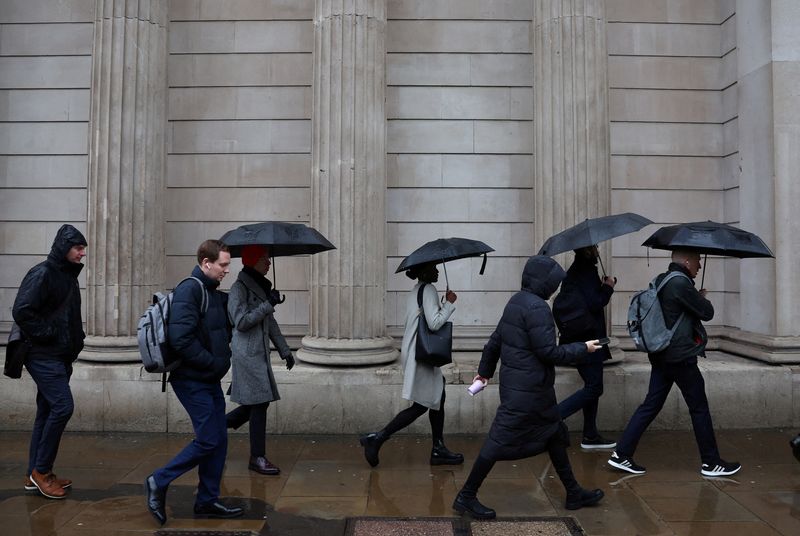Investing.com’s stocks of the week
By Suban Abdulla and William Schomberg
LONDON (Reuters) -Britain's labour market lost a bit more of its inflationary heat, data showed on Tuesday, offering some relief to the Bank of England, but stubborn underlying problems continued with wage growth still high and more people dropping out of the workforce.
Core wages rose by the least since mid-2022 in the three months to February but remained strong by historical standards, according to the Office for National Statistics figures.
Regular wages excluding bonuses - which BoE is watching as it considers when to start cutting interest rates - grew by 6.0% compared with the same period a year earlier, only slightly weaker than a 6.1% rise in the November-to-January period.
A Reuters poll of economists had forecast a sharper slowdown to 5.8%.
The unemployment rate rose by more than expected to 4.2% from 3.9%, also suggesting a loss of momentum in the jobs market, but the ONS said it was still overhauling its survey which produces that figure and it was subject to volatility.
Yael Selfin, chief economist at KPMG UK, said the rise in the unemployment rate and the latest slowing of pay pressure suggested the labour market was generating less inflation.
"The slight easing in regular pay growth will bring some comfort for the Bank of England which has relied on the pay data as a key gauge of domestic inflationary pressure," Selfin said.
Sterling briefly fell against the U.S. dollar and euro immediately after the data was published, and investors trimmed their bets on BoE rate cuts this year with a first reduction in Bank Rate fully priced in for September.
Growth in total pay, which includes more volatile bonus payments, was unchanged at 5.6%. The Reuters poll had pointed to a slight slowdown to 5.5%.
Strong pay increases have eased the squeeze on household finances which were hit by the surge in inflation in 2022, offering some hope to Prime Minister Rishi Sunak who is battling weak opinion poll ratings before an election expected this year.
Tuesday's figures showed regular pay adjusted for the consumer price index rose by 2.1% in the three months to February, the biggest annual increase since mid-2021.
CONCERNS REMAIN
The rate of inactivity in the jobs market - which measures people who are not in employment or seeking work and which the BoE hopes to see fall to ease pressure on wages and inflation - rose to 22.2%, the highest since mid-2015.
The number of people registered as long-term sick hit its highest since records began in 1993 at 2.83 million.
"The UK's labour market looks increasingly two-speed. Unemployment is rising and inactivity persists," Matthew Percival, the Confederation of British Industry's future of work & skills director, said.
"Meanwhile there remain a heightened number of jobs that employers can't fill, causing pay to rise faster than compatible with significantly cutting interest rates."
Vacancies fell for the 21st time in a row in the three months to March, dropping by 13,000 from the October-to-December period and down by 204,000 on a year earlier at 916,000. But they remained 120,000 above their pre-COVID level.
"The labour market continues to gradually cool but continued high wage growth underlines concerns over inflation persistence," Jack Kennedy, senior economist at jobs platform Indeed, said.
"With stubborn US inflation having dimmed hopes of an imminent Fed rate cut, prospects for UK rate cuts being cut before autumn also look questionable."
Britain's minimum wage for workers aged 21 and above rose by almost 10% to 11.44 pounds ($14.23) an hour earlier this month. Some employers have said big increases in recent years - which reflect in large part the jump in inflation - have put pressure on them to increase their prices or reduce hiring.
The Recruitment and Employment Confederation said last week that demand for staff fell for the fifth month in a row in March.
($1 = 0.8039 pounds)
